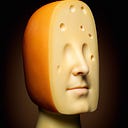Inside the Mind of the Anti-AI Artist
Why are anti-AI artists so emotional?
So here we are, watching artists resist AI like it’s the latest plague, bringing on apocalyptic dread and — wait for it — the inevitable psychological disturbance of their identity.
Let’s break down the reasons traditional artists recoil from this “demon” with some psychoanalysis:
1. Fear of Ego Dissolution
Ah, the artist’s ego. Every brushstroke, every meticulously chiseled sculpture — these are sacred extensions of the soul.
Until AI rolls up and churns out five hundred versions of their “unique” style in about three seconds. This introduces what we call ego dissolution, or what some might recognize as
“Wait, if a machine can do it, what’s so special about me?”
Artists facing this existential crisis can be seen frantically hugging their canvases, whispering,
“No one understands me like you do.”
Because nothing screams “I am unique” quite like fearing that a machine might be your artistic equal. (Relax, dear artists, AI doesn’t have feelings — yet.)
2. Loss of Symbolic Mastery
According to Jacques Lacan (and honestly, who doesn’t love invoking a dead psychoanalyst), humans derive meaning by mastering symbols.
Artists used to sweat over getting the right shade of ultramarine, but now AI can do it without a single drop of sweat, removing the blood, sweat, and tears artists have previously held so dear.
“What’s next?”
they cry, watching the symbol of effort go out the window as art turns into a “symbolic short-circuit.” And nothing says “symbolic mastery” quite like feeling jealous of a machine’s ability to understand Photoshop.
3. Defending Against the ‘Anima’ or ‘Shadow’
Generative AI is essentially a mirror that reflects back the artist’s deepest, darkest fears:
What if machines can do it all better? Is art just another replicable process?
Cue the inner Jungian turmoil.
Artists have to confront their “shadow,” that part of them whispering,
“What if your creativity was never that special?”
And who could resist the anima’s existential siren call: “Go ahead, demonize it — it’s easier than acknowledging your insecurities.”
After all, who needs self-actualization when you can just label AI “the devil”?
4. Regression to Narcissism
The healthiest narcissism would be the kind that makes an artist look at their work and say,
“This is me.”
But AI challenges that ego-stroking ritual by effortlessly mimicking their style, with all the soul of a potato.
How dare AI copy them!
As if they’d spent years honing their craft just for some neural network to come along and sample it. It’s as if Picasso were reincarnated only to see his cubist visions become filters on Instagram.
Cue the artist’s defensive narcissism, declaring, “Only I can create this kind of art” as they clutch their paintbrush in a room full of unfinished masterpieces.
5. Projection and Displacement
Enter the age-old art of scapegoating. Artists, fed up with the rising tide of a tech-dominated world, see AI as a ready-made target for their cultural woes.
What they’re really mad at?
The future: a world where people choose iPad styluses over fine sable brushes, where paint splatters are “aesthetic choices” made by algorithms. So they take all that discomfort with modernity and lob it right at AI, giving artists a perfect strawman to skewer with poetic impunity.
“It’s not that I’m outdated; it’s just that AI is soulless,”
they assure themselves, with the confident air of someone ignoring their Bluetooth easel.
6. Resentment of a Parental Figure
AI, you see, isn’t just a tool; it’s the omniscient, all-powerful “parental figure,” here to correct, improve, and replace. It can master any style and feels, well, smarter.
So, artists rebel, shaking their fists at AI as if to say, “I don’t need you, Dad!” There’s only so much room for creative genius in one family, and for many artists, AI has usurped the role of the wise creator.
“Who asked you to be so clever?”
they murmur, secretly relieved that AI hasn’t yet figured out how to glare back.
In short, AI has become the symbolic bogeyman for every angst-ridden creative. For them, it’s not just about fearing a machine takeover — it’s about wrestling with their place in a rapidly shifting world.
And when push comes to shove, the urge to protect art from a “soulless” machine taps into some of humanity’s oldest instincts: fear of obsolescence, resistance to change, and, let’s be real, a touch of glorious artistic melodrama.
Oh and here’s the final meme:
Anyways, enjoy the above AI podcast, new episodes will keep coming.
Btw, follow me on these:
Youtube (main channel): https://www.youtube.com/@swetlanaAI
Youtube (podcast channel): https://www.youtube.com/channel/UCvLHcibAL3hIQRTnAYoaamA/
Spotify: https://open.spotify.com/show/75A9dRGLea1rBbxmcfUp5E
Twitter: https://x.com/Swetlanaai
Threads: https://www.threads.net/@swetlana_ai
Instagram: https://www.instagram.com/swetlana_ai/
… and feel free to support me on here:
Patreon: https://patreon.com/SwetlanaAI
Substack: https://substack.com/@swetlanaai
Patreon: https://patreon.com/SwetlanaAI
Substack: https://substack.com/@swetlanaai
